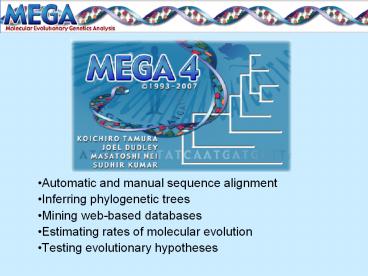Automatic and manual sequence alignment - PowerPoint PPT Presentation
Title:
Automatic and manual sequence alignment
Description:
Automatic and manual sequence alignment Inferring phylogenetic trees Mining web-based databases Estimating rates of molecular evolution Testing evolutionary hypotheses – PowerPoint PPT presentation
Number of Views:173
Avg rating:3.0/5.0
Title: Automatic and manual sequence alignment
1
- Automatic and manual sequence alignment
- Inferring phylogenetic trees
- Mining web-based databases
- Estimating rates of molecular evolution
- Testing evolutionary hypotheses
2
- Mega works on Windows, Mac OS, and Linux
- You can download the new version Mega 5, or
the older versions.
3
Get the mRNA sequence of chicken LDH-A (accession
X53828) from the database
Choose Query Databanks
4
Get the mRNA sequence of chicken LDH-A (accession
X53828) from the database
Choose Query Databanks Search for the sequence
5
Get the mRNA sequence of chicken LDH-A (accession
X53828) from the database
Choose Query Databanks Search for the
sequence Add to Alignment
6
Now, get only the CDS
Scroll down and follow the link to the CDS
7
Now, get only the CDS
- Scroll down and follow the link to the CDS
- Get the fasta sequence
- Add to Alignment
8
Alignment Explorer
Close the MEGA Web-Browser and examine the mRNA
and CDS sequences
9
Alignment Explorer
Edit the names of the sequences
10
Alignment Explorer
Edit the names of the sequences
11
Alignment Explorer
Align the DNA sequences
12
Alignment Explorer
Can you identify the start site of translation?
13
Alignment Explorer
Translate the alignment to protein. Whats wrong
here?
14
Alignment Explorer
At the DNA level, cut the UTR region from the mRNA
15
Alignment Explorer
Align the DNA sequences again and translate to
proteins
16
Alignment Explorer
Create a new alignment, from the FASTA file
ldh_a-c.fas
17
Alignment Explorer
- You can either (1) align the sequences at the DNA
level and then translate to protein sequences, or
(2) translate the DNA sequences to protein
sequences and then get the alignment. - Try both. Which one gives better results?
18
Further analysis
- Export alignment to mega format
- Save the data to a MEGA file
- Give it an appropriate title
- Specify if it is a protein-coding sequences
- Open the data file in the Sequence Data Explorer
19
Further analysis
To be continued

